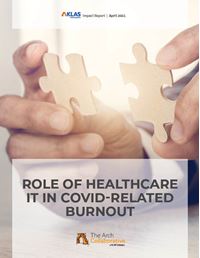Role of Healthcare IT in COVID-Related Burnout
After a year of packed ICUs, PPE shortages, and other COVID-19 related stressors, there is hopefully light at the end of the tunnel, with vaccines becoming widely available and COVID-19 case numbers declining. However, the pandemic has certainly had significant impacts on the healthcare community. This report explores the impact on clinician burnout and examines whether healthcare technology has played a role in current levels of burnout.
Want to see full details?
Want to see full details?
Here is my information:
Clinician Burnout Has Increased since 2019
In 2019, 24% of all clinician respondents to the Arch Collaborative survey reported some degree of burnout.† After a year of dealing with the strain of COVID-19, that number went up by 4 percentage points. The increase was similar regardless of respondent background, indicating that both nurses and physicians felt the increased pressure.
† This percentage is very similar to burnout rates reported in earlier Arch Collaborative reports that focused specifically on burnout among nurses (24.6%) and physicians (28%).



However, as a CMIO pointed out, some respondents may be underestimating their current stress levels: “I ask everybody what their stress level is, and it is amazing the number of people who say it is low or that things aren’t that bad. But then they tell me the things that are going on in their life and all the things they are doing, and I realize that people have become desensitized. They think it is just the way life is now.”
While many factors may be influencing the current levels of self-reported burnout, COVID-19 is often an underlying cause. This is true in the case of stressors such as financial worries, increased patient death, and fear of contracting the virus or passing it on to others. A VP stated, “The pandemic has affected a lot of hospitals’ financials, and I think there have been rifts because of that. We were already having to do more with less, and I think the pandemic just exacerbated that. That is creating a lot of additional stress and burnout that maybe didn’t exist prior to the pandemic.”
Technology Not the Largest Contributor to Increased Burnout
“I don’t think technology played a significant role in burnout related to the pandemic. I think other factors led more to burnout, such as having to gear up in such heavy gear, tell families they couldn’t be at their loved one’s bedside, and deal with the stress of caring for large volumes of really sick people who were dying in numbers we weren’t used to. I think those things led more to burnout. At first, it was great to see how much people appreciated us and to see people go outside to clap and cheer for us at nighttime. I think that made healthcare people feel really great. But we are a year into this now, and some of the magic has worn off.” —CMIO

A CMIO explained why this is the case: “Software has been very available because a lot of restrictions around things like telehealth were loosened. The federal government allowed the use of things like FaceTime to get in touch with patients. Hardware was more difficult to get. Things like webcams and laptops were hard to come by at the beginning. If organizations didn’t already have a backlog of those, their users weren’t getting them. That has settled down for the most part, though tablets are still tough to get at times. IT support resources got slammed. People were using new tablets with new software, and they had no idea how to use them. And patients had no idea how to use the technology on their end. So the IT support resources just got buried. I don’t think they were prepared to handle the volume or the complexity. There is no way they could have been.”
While technology does not seem to be the largest contributor to burnout during the pandemic, for both providers and nurses, having the right software, hardware, and IT support appears to have helped them better handle the stresses of COVID-19 and alleviated some feelings of burnout. Clinicians who feel they had the software, hardware, or IT support they needed tend to report lower rates of burnout than peers who don’t feel they had the needed technology. See the full report for more details on the impact of specific types of technology, including telehealth.

Arch Collaborative Findings on Addressing Clinician Burnout
Explore the following case studies and webinars for ideas on how to address burnout in your organization:
Case Studies
- “Super Thrive Program” (Legacy Health)
- “Provider Representation” (WakeMed)
- “Physician Liaisons” (JPS Health Network)
Webinars
- “Improving Wellness by Paying Attention” (Spectrum Health)
- “Impacting Physician Burnout with Virtual Scribes” (Community Health Network & Aquity)
- “Improving Life by 1,000 Correlations” (2020 Arch Collaborative Learning Summit)

Report Non-Public HTML Body
Report Public HTML Body
This material is copyrighted. Any organization gaining unauthorized access to this report will be liable to compensate KLAS for the full retail price. Please see the KLAS DATA USE POLICY for information regarding use of this report. © 2019 KLAS Research, LLC. All Rights Reserved. NOTE: Performance scores may change significantly when including newly interviewed provider organizations, especially when added to a smaller sample size like in emerging markets with a small number of live clients. The findings presented are not meant to be conclusive data for an entire client base.



